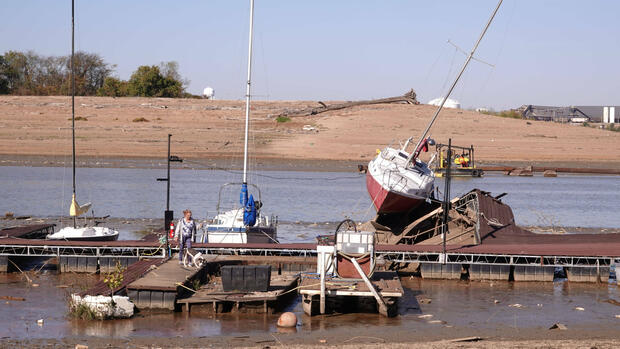new York The ongoing drought threatens the most important waterways in the USA: Logistics on the Mississippi, the most important American transport river, is in danger for the second year in a row. The cargo ships are already sailing with reduced loads. Without new rain, the transport of this year’s harvest is threatened. The Colorado River is also continuing to dry out, endangering not only tourism but also the supply of entire cities.
The reason is the hot temperatures and the lack of rain in the north of the USA. More and more companies also have the water levels of the largest rivers on their radar. Not just that of the Mississippi, but also that of the Rhine, the Danube and the Elbe.
“Companies today are much more aware of the danger of low water levels in the rivers than they were just a few years ago,” the consultant states. As early as January and February, many companies were thinking about what would happen if the Rhine, Danube or Elbe had too little water in August, what alternatives there were for transport and what would happen to the suppliers, reports Schnellbächer.
After all, it is not easy to simply switch transport to the road. “We already have a shortage of truck drivers,” he explains.
This year the focus is on US rivers
“Since the major European rivers got off lightly again this year, companies are now looking to the USA,” he observes. “The USA is particularly important as a supplier for the chemical industry. If, for example, even one component in the specialty chemicals is missing, that can become a big problem.”
In particular, the almost 3,800 kilometer long Mississippi River with its important tributaries such as the Ohio and Missouri Rivers is so wide that up to 40 barges can be tied together and transported there. Such huge loads are difficult to transport by truck.
“We need rain in the northern United States so that we can maintain our shipping traffic throughout the season,” said Chris Chinn, Missouri Secretary of Agriculture. “Right now our cargo ships can only operate at 60 to 80 percent capacity and that drives up transportation costs, which is never good.”
Last year, more than 2,000 barges were stranded because the water level was too low. And this year the dry spell started early, warns Chinn.
Soy, corn and chemicals reach export ports via the Mississippi River
The soybean and corn harvests from the Midwest in particular travel via the Mississippi to the important export ports south of New Orleans on the Gulf of Mexico. But fertilizer and other chemical products are also transported across the river.
Lake levels on the border of Nevada and Arizona have continued to fall.
(Photo: AP)
“It currently looks as if we will have transportation interruptions again in the coming months,” warns Jon Davis, chief meteorologist at Everstream Analytics. “The water level is currently one of the lowest in the last 10 to 20 years,” says Davis.
With water levels so low, the barges can only carry a smaller load. This means that more barges are needed to transport the same amount. “Besides, you can’t tie 40 barges together when the water is low,” Davis points out. All of this drives up transport costs.
According to the U.S. Department of Agriculture, freight costs on the Mississippi were already 85 percent higher than the three-year average at the end of August.
Meteorologist: Transport problems due to droughts are becoming more frequent
The prospects for the coming years are also not good: “It is likely that we will have more frequent droughts in the future in which transport will be restricted,” predicts meteorologist Davis. The problem is not limited to the Mississippi and its tributaries. Davis points to the Panama Canal, where hundreds of cargo ships are currently waiting to pass through due to the drought.
The Colorado River, which flows from the Rocky Mountains through the Grand Canyon into the Gulf of California, is also dwindling more and more to a trickle. “It’s also because agriculture and so many cities divert water,” explains Davis.
The river that flows from the Rocky Mountains to the Gulf of California is dwindling to a trickle.
(Photo: AP)
If the Colorado River dries up, it’s not just the tourism industry that has a problem, which generates $9 billion in revenue from boating, rafting and fishing. 40 million people and many farms could also run out of water.
In May, the Biden administration therefore concluded a contract with Arizona, California, Nevada and various Native American tribes: They agreed to use less water and received a total of $1.2 billion in return.
The problem is not yet solved. “But any help is welcome,” says Davis of Everstream Analytics.
German companies are shortening their supply chains
According to the consultant Schnellbächer, at least German companies are reacting to these drought and supply chain risks primarily with nearshoring: “So they are bringing production and suppliers as far as possible to Germany,” he explains.
Some also increasingly went to the USA to produce for the American market, observes Schnellbächer. “But then they also look for suppliers in the USA.”
More: “Climate change has reached the water supply”
